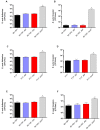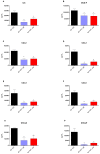Study of the Role of Lipoprotein Maturation Enzymes in the Pathogenesis of the Infection Caused by the Streptococcus suis Serotype 2 Sequence Type 25 North American Prototype Strain
- PMID: 38003790
- PMCID: PMC10675726
- DOI: 10.3390/pathogens12111325
Study of the Role of Lipoprotein Maturation Enzymes in the Pathogenesis of the Infection Caused by the Streptococcus suis Serotype 2 Sequence Type 25 North American Prototype Strain
Abstract
Streptococcus suis serotype 2 is an important swine bacterial pathogen causing sudden death, septic shock, and meningitis. However, serotype 2 strains are phenotypically and genotypically heterogeneous and composed of a multitude of sequence types (STs) whose distributions greatly vary worldwide. It has been previously shown that the lipoprotein (LPP) maturation enzymes diacylglyceryl transferase (Lgt) and signal peptidase (Lsp) significantly modulate the inflammatory host response and play a differential role in virulence depending on the genetic background of the strain. Differently from Eurasian ST1/ST7 strains, the capsular polysaccharide of a North American S. suis serotype 2 ST25 representative strain only partially masks sub-capsular domains and bacterial wall components. Thus, our hypothesis is that since LPPs would be more surface exposed in ST25 strains than in their ST1 or ST7 counterparts, the maturation enzymes would play a more important role in the pathogenesis of the infection caused by the North American strain. Using isogenic Δlgt and Δlsp mutants derived from the wild-type ST25 strain, our studies suggest that these enzymes do not seem to play a role in the interaction between S. suis and epithelial and endothelial cells, regardless of the genetics background of the strain used. However, a role in the formation of biofilms (also independently of the STs) has been demonstrated. Moreover, the involvement of LPP dendritic cell activation in vitro seems to be somehow more pronounced with the ST25 strain. Finally, the Lgt enzyme seems to play a more important role in the virulence of the ST25 strain. Although some differences between STs could be observed, our original hypothesis that LPPs would be significantly more important in ST25 strains due to a better bacterial surface exposition could not be confirmed.
Keywords: North America; Streptococcus suis; inflammation; lipoprotein maturation enzymes; serotype 2.
Conflict of interest statement
The authors declare no conflict of interest.
Figures








Similar articles
-
Role of Maturation of Lipoproteins in the Pathogenesis of the Infection Caused by Streptococcus suis Serotype 2.Microorganisms. 2021 Nov 19;9(11):2386. doi: 10.3390/microorganisms9112386. Microorganisms. 2021. PMID: 34835511 Free PMC article.
-
Role of the Streptococcus suis serotype 2 capsular polysaccharide in the interactions with dendritic cells is strain-dependent but remains critical for virulence.PLoS One. 2018 Jul 12;13(7):e0200453. doi: 10.1371/journal.pone.0200453. eCollection 2018. PLoS One. 2018. PMID: 30001363 Free PMC article.
-
Type I Interferon Induced by Streptococcus suis Serotype 2 is Strain-Dependent and May Be Beneficial for Host Survival.Front Immunol. 2017 Aug 28;8:1039. doi: 10.3389/fimmu.2017.01039. eCollection 2017. Front Immunol. 2017. PMID: 28894449 Free PMC article.
-
Streptococcus suis: a re-emerging pathogen associated with occupational exposure to pigs or pork products. Part II - Pathogenesis.Ann Agric Environ Med. 2018 Mar 14;25(1):186-203. doi: 10.26444/aaem/85651. Epub 2018 Mar 2. Ann Agric Environ Med. 2018. PMID: 29575852 Review.
-
Virulence factors involved in the pathogenesis of the infection caused by the swine pathogen and zoonotic agent Streptococcus suis.Future Microbiol. 2012 Feb;7(2):259-79. doi: 10.2217/fmb.11.149. Future Microbiol. 2012. PMID: 22324994 Review.
References
-
- Goyette-Desjardins G., Auger J.P., Xu J., Segura M., Gottschalk M. Streptococcus suis, an important pig pathogen and emerging zoonotic agent-an update on the worldwide distribution based on serotyping and sequence typing. Emerg. Microbes Infect. 2014;3:e45. doi: 10.1038/emi.2014.45. - DOI - PMC - PubMed
LinkOut - more resources
Full Text Sources

